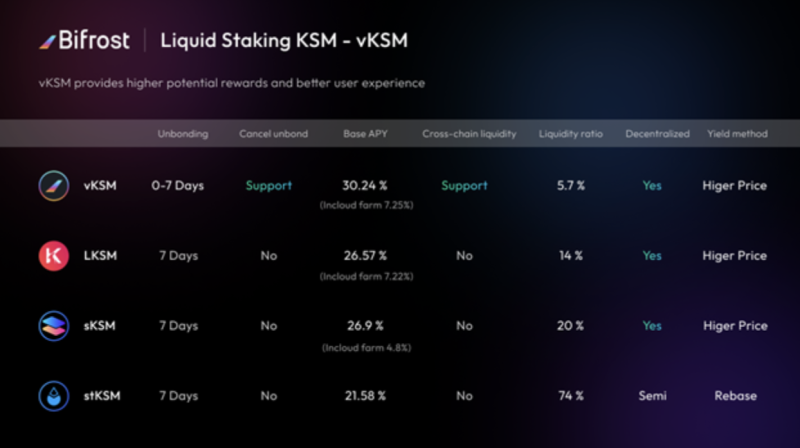As Stake-Fi economy grows Bifrost sees over 97k ($4.6m) KSM liquid derivatives minted

Liquid staking and StakeFi economy are making big strides towards the future of Web3. As DeFi dapp ecosystems utility grows, crypto lovers want to use their coins for DeFi applications, yet many of them don’t since they don’t want to miss out on the lucrative staking rewards. As the conflict between DeFi and Staking arises, solutions emerge. Naturally, StakeFi is becoming more and more popular — it’s a sort of have your cake and eat it mechanism. So what has been going on in the StakeFi sector recently and why are we only finding about Bifrost now?
Seeing over 97,000 of KSM ($4.6m) liquid derivatives minted since the launch of Bifrost’s Staking Liquidity Protocol (SLP), Bifrost is growing exponentially, and looking to be an important cross chain liquidity staking hub within DeFi. Data gathered between May and June earlier this year showed that among other liquid staking solutions, Bifrost had the highest increase in the amount of liquid KSM derivatives minted. And the reason crypto holders are turning to Bifrost is simple: Bifrost creates competitive advantage and differences on the protocol level.

Built on Substrate, Bifrost holds the advantage to upgrade functionalities effectively and efficiently in comparison to other smart contract liquid staking solutions, with additional flexibility and consistency on product updates and rapid incorporation of user feedback. One such special functionality that stems from the protocol’s flexibility is the unbonding time. For vKSM (KSM liquid staking derivative), Bifrost allows a 0-7 days redemption period, rather than fixed 7 days, and even supports cancel redemption, which many crypto holders might find especially appealing.
Cross chain staking
If 30% APY on staking and the quickest unbonding time on the market aren’t enough, Bifrost offers something else, which is the reason why early StakeFi adopters and fierce dapp users are choosing Bifrost. The cross-chain interoperability of liquid staking is one of the main factors driving the utility for liquid derivatives and amplifying their use cases within numerous DeFi scenarios. Working as both Kusama and Polkadot parachains and leveraging the XCM Cross Chain Messaging functionality to build use cases and leverage utility, Bifrost has the potential to launch liquid staking not only on Polkadot and Kusama but also on their parachains. With vKSM (KSM liquid derivative) already live, vDOT and other parachain liquid derivatives along the way of Bifrost’s roadmap as well as plans to bridge to other PoS chains such as Ethereum 2.0, Cosmos, and many more.

Bifrost staking derivatives have a unified interface, a common redemption method and an interest calculation approach, forged by the same set of agreements. By building these derivatives on XCM, each different derivative will hold the potential to be traded, while derivatives will be additionally able to generate loans to one another. There will be a potential for liquidity to be shared amongst all liquid derivatives.
StakeFi economy has much growth potential but it can be realized only with Web3 making the cross-chain future possible. If we believe in a cross-chain future, we need derivatives that will help build the three key pillars for StakeFi: standardization, security, and liquidity. Bifrost is already built on this decentralized foundation. In the cross-chain StakeFI future, users should not be forced to choose and stick to one or a couple protocols and treat them as a complete ecosystem. If crypto is to see mass adoption, we need a unified cross chain DeFi and StakeFi solutions. With their cross-chain StakeFi model, Bifrost is building a truly decentralized future of the unified, shared liquidity ecosystem. Through the combination of security, liquidity, and high standardization of derivatives, Bifrost will ensure growth and mass cross-chain staking adoption.
This post is commissioned by Bifrost and does not serve as a testimonial or endorsement by The Block. This post is for informational purposes only and should not be relied upon as a basis for investment, tax, legal or other advice. You should conduct your own research and consult independent counsel and advisors on the matters discussed within this post. Past performance of any asset is not indicative of future results.






 Bitcoin
Bitcoin  Ethereum
Ethereum  Tether
Tether  USDC
USDC  TRON
TRON  Dogecoin
Dogecoin  Cardano
Cardano  Bitcoin Cash
Bitcoin Cash  Chainlink
Chainlink  LEO Token
LEO Token  Zcash
Zcash  Monero
Monero  Stellar
Stellar  Litecoin
Litecoin  Hedera
Hedera  Dai
Dai  Cronos
Cronos  OKB
OKB  Tether Gold
Tether Gold  Ethereum Classic
Ethereum Classic  KuCoin
KuCoin  Gate
Gate  Algorand
Algorand  Cosmos Hub
Cosmos Hub  VeChain
VeChain  Tezos
Tezos  Dash
Dash  TrueUSD
TrueUSD  Stacks
Stacks  IOTA
IOTA  Basic Attention
Basic Attention  Decred
Decred  Theta Network
Theta Network  NEO
NEO  Qtum
Qtum  Synthetix
Synthetix  0x Protocol
0x Protocol  Ravencoin
Ravencoin  DigiByte
DigiByte  Zilliqa
Zilliqa  Nano
Nano  Siacoin
Siacoin  Numeraire
Numeraire  Waves
Waves  Ontology
Ontology  BUSD
BUSD  Status
Status  Enjin Coin
Enjin Coin  Hive
Hive  Pax Dollar
Pax Dollar  Lisk
Lisk  Steem
Steem  Huobi
Huobi  OMG Network
OMG Network  NEM
NEM  Bitcoin Gold
Bitcoin Gold  Augur
Augur